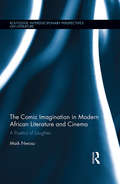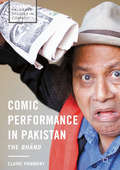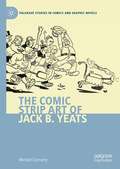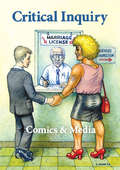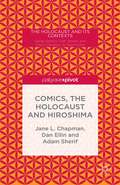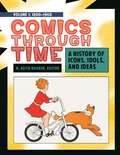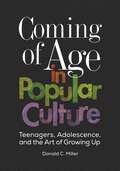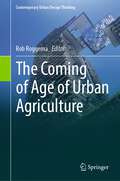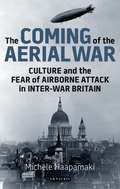- Table View
- List View
The Comic Imagination in Modern African Literature and Cinema: A Poetics of Laughter (Routledge Interdisciplinary Perspectives on Literature)
by Maik NwosuThis book is a seminal study that significantly expands the interdisciplinary discourse on African literature and cinema by exploring Africa’s under-visited carnivalesque poetics of laughter. Focusing on modern African literature as well as contemporary African cinema, particularly the direct-to-video Nigerian film industry known as Nollywood, the book examines the often-neglected aesthetics of the African comic imagination. In modern African literature, which sometimes creatively traces a path back to African folklore, and in Nollywood — with its aesthetic relationship to Onitsha Market Literature — the pertinent styles range from comic simplicitas to comic magnitude with the facilitation of language, characterization, and plot by a poetics of laughter or lightness as an important aspect of style. The poetics at work is substantially carnivalesque, a comic preference or tendency that is attributable, in different contexts, to a purposeful comic sensibility or an unstructured but ingrained or virtual comic mode. In the best instances of this comic vision, the characteristic laughter or lightness can facilitate a revaluation or reappreciation of the world, either because of the aesthetic structure of signification or the consequent chain of signification. This referentiality or progressive signification is an important aspect of the poetics of laughter as the African comic imagination variously reflects, across genres, both the festival character of comedy and its pedagogical value. This book marks an important contribution to African literature, postcolonial literature, world literature, comic imagination, poetics, critical theory, and African cinema.
The Comic Imagination in Modern African Literature and Cinema: A Poetics of Laughter (Routledge Interdisciplinary Perspectives on Literature)
by Maik NwosuThis book is a seminal study that significantly expands the interdisciplinary discourse on African literature and cinema by exploring Africa’s under-visited carnivalesque poetics of laughter. Focusing on modern African literature as well as contemporary African cinema, particularly the direct-to-video Nigerian film industry known as Nollywood, the book examines the often-neglected aesthetics of the African comic imagination. In modern African literature, which sometimes creatively traces a path back to African folklore, and in Nollywood — with its aesthetic relationship to Onitsha Market Literature — the pertinent styles range from comic simplicitas to comic magnitude with the facilitation of language, characterization, and plot by a poetics of laughter or lightness as an important aspect of style. The poetics at work is substantially carnivalesque, a comic preference or tendency that is attributable, in different contexts, to a purposeful comic sensibility or an unstructured but ingrained or virtual comic mode. In the best instances of this comic vision, the characteristic laughter or lightness can facilitate a revaluation or reappreciation of the world, either because of the aesthetic structure of signification or the consequent chain of signification. This referentiality or progressive signification is an important aspect of the poetics of laughter as the African comic imagination variously reflects, across genres, both the festival character of comedy and its pedagogical value. This book marks an important contribution to African literature, postcolonial literature, world literature, comic imagination, poetics, critical theory, and African cinema.
The Comic Offense from Vaudeville to Contemporary Comedy: Larry David, Tina Fey, Stephen Colbert, and Dave Chappelle
by Rick DesRochersThe Comic Offense from Vaudeville to Contemporary Comedy examines how contemporary writer/performers are influenced by the comedic vaudevillians of the early 20th century. By tracing the history and legacy of the vaudeville era and performance acts, like the Marx Brothers and The Three Keatons, and moving through the silent and early sound films of the early 1930s, the author looks at how comic writer/performers continue to sell a brand of themselves as a form of social commentary in order to confront and dispel stereotypes of race, class, and gender. The first study to explore contemporary popular comic culture and its influence on American society from this unique perspective, Rick DesRochers analyzes stand-up and improvisational comedy writing/performing in the work of Larry David, Tina Fey, Stephen Colbert, and Dave Chappelle. He grounds these choices by examining their evolution as they developed signature characters and sketches for their respective shows Curb Your Enthusiasm, 30 Rock, The Colbert Report, and Chappelle's Show.
The Comic Offense from Vaudeville to Contemporary Comedy: Larry David, Tina Fey, Stephen Colbert, and Dave Chappelle
by Rick DesRochersThe Comic Offense from Vaudeville to Contemporary Comedy examines how contemporary writer/performers are influenced by the comedic vaudevillians of the early 20th century. By tracing the history and legacy of the vaudeville era and performance acts, like the Marx Brothers and The Three Keatons, and moving through the silent and early sound films of the early 1930s, the author looks at how comic writer/performers continue to sell a brand of themselves as a form of social commentary in order to confront and dispel stereotypes of race, class, and gender. The first study to explore contemporary popular comic culture and its influence on American society from this unique perspective, Rick DesRochers analyzes stand-up and improvisational comedy writing/performing in the work of Larry David, Tina Fey, Stephen Colbert, and Dave Chappelle. He grounds these choices by examining their evolution as they developed signature characters and sketches for their respective shows Curb Your Enthusiasm, 30 Rock, The Colbert Report, and Chappelle's Show.
Comic Performance in Pakistan: The Bhānd (Palgrave Studies in Comedy)
by Claire PammentThis book explores comic performance in Pakistan through the vibrant Indo-Muslim tradition of the Punjabi bhānd which now holds a marginal space in contemporary weddings. With irreverent repartee, genealogical prowess, a topsy-turvy play with hierarchies and shape shifting, the low-status bhānd jostles space in otherwise rigid class and caste hierarchies. Tracing these negotiations in both historical and contemporary sites, the author unfolds a dynamic performance mode that travels from the Sanskrit jester and Sufi wise fool, into Muslim royal courts and households, weddings, contemporary carnivalesque and erotic popular Punjabi theatre and satellite television news. Through original historical and ethnographic research, this book brings to life hitherto unexplored territories of Pakistani popular culture and Indo-Muslim performance histories.
Comic Sans: The Biography of a Typeface (The ABC of Fonts) (The ABC of Fonts)
by Simon GarfieldComic Sans is one of the most used and most reviled typefaces of the digital age. How was it made? How could it spawn a movement to ban it and yet still be so widely promoted by educators? What does its accidental creator make of its contentious and singular history?This quirky and unique book considers how the computer transformed type into something that anyone could use and have an opinion on. It examines how a typeface, correctly used, may sell us almost anything, and how new types with names such as Crash Soul, Lovely Scream Queens and Ampersandist (to name but three recent examples of the hundreds issued each year) each attempt to keep the alphabet exciting and new. And it concludes with an alluring question: could Comic Sans now be the coolest typeface ever made?
The Comic Strip Art of Jack B. Yeats (Palgrave Studies in Comics and Graphic Novels)
by Michael ConnertyThis monograph seeks to recover and assess the critically neglected comic strip work produced by the Irish painter Jack B. Yeats for various British publications, including Comic Cuts, The Funny Wonder, and Puck, between 1893 and 1917. It situates the work in relation to late-Victorian and Edwardian media, entertainment and popular culture, as well as to the evolution of the British comic during this crucial period in its development. Yeats’ recurring characters, including circus horse Signor McCoy, detective pastiche Chubblock Homes, and proto-superhero Dicky the Birdman, were once very well-known, part of a boom in cheap and widely distributed comics that Alfred Harmsworth and others published in London from 1890 onwards. The repositioning of Yeats in the context of the comics, and the acknowledgement of the very substantial corpus of graphic humour that he produced, has profound implications for our understanding of his artistic career and of his significant contribution to UK comics history. This book, which also contains many examples of the work, should therefore be of value to those interested in Comics Studies, Irish Studies, and Art History.
The Comical: A Philosophical Analysis (Nijhoff International Philosophy Series #47)
by B. DziemidokThe problem of the comical is one of the most interesting issues in aesthetics. Its significance extends well beyond the sphere of aesthetic studies and has at tracted the attention of the scholars working in other fields such as the theorists and historians of particular art forms, sociologists, psychologists, as well as anthropologists, ethnographers and the theorists of education. Philosophy has devoted a lot of attention to the comical. Since Aristotle al most every philosopher has felt obliged to comment on this question. However, even though they have offered a number of accurate observations on the subject, the philosophers involved in the discussion about the comical have earned a reputation of being rather devoid of the sense of the comical and many a time their considerations have been compared to those of a blind man talking about colours. And yet the problem of the comical kept attracting them to such an ex tent that they paid no heed to the difficulties involved and neglected the risk of becoming ridiculous themselves. Adolf Zeissing once remarked that all the litera ture on the comical is a "comedy of errors" committed while defining the comi cal. Yet even he could not resist the temptation of adding another page to this "comedy of errors". Tadeusz Boy-Zeleriski claimed that the good thing about the philosophical writing concerning the comical is that it offers not only the theory of the comical but at the same time is the theory's practical application.
Comics and Conquest: Political Cartoons And A Radical Retelling Of The Navajo-hopi Land Dispute
by Rhiannon KoehlerComics - Bilder, Stories und Sequenzen in religiösen Deutungskulturen (Kulturelle Figurationen: Artefakte, Praktiken, Fiktionen)
by Jo¨ Ahrens Frank T. Brinkmann Nathanael RiemerComics sind fester Bestandteil spätmoderner Text- und Zeichenwelten. Sie haben der Gegenwartskultur nicht nur Storys und Sagenkränze beschert, sondern auch Mythen, Ikonen und Helden. Dass die skizzierten Protagonisten bisweilen auch als Antihelden konstruiert werden – und sich die Erzählungen insofern auch als Antimythen aufstellen – bekräftigt im Grunde die These von einer comic-literarischen Heldenreise, auf deren Sinn und Funktion sowohl die Religions- als auch die Medienwissenschaften aufmerksam gemacht haben. Der Comic als Medium hat Rezeptionsgewohnheiten verändert und Reflexionsstrategien neu gestaltet. Populäre Erzählmuster sind von der Trivialität und Banalität der Strips und Cartoons ebenso beeinflusst worden wie die intellektuellen Diskurse von den metatextuellen Realitätskonstruktionen der Graphic Novel.
Comics & Media: A Special Issue of "Critical Inquiry" (A Critical Inquiry Book)
by Hillary L. Chute Patrick JagodaThe past decade has seen the medium of comics reach unprecedented heights of critical acclaim and commercial success. Comics & Media reflects that, bringing together an amazing array of contributors--creators and critics alike--to discuss the state, future, and potential of the medium. Loaded with full-color reproductions of work by such legends as R. Crumb, Art Spiegelman, Alison Bechdel, Chris Ware, Daniel Clowes, and Lynda Barry, the book addresses the place of comics in both a contemporary and historical context. Essays by such high-profile figures as Tom Gunning, N. Katherine Hayles, Patrick Jagoda, and W. J. T. Mitchell address a stunning range of topics, including the place of comics in the history of aesthetics, changes to popular art forms, digital humanities, and ongoing tensions between new and old media. The result is a substantial step forward for our understanding of what comics are and can be, and the growing place they hold in our culture.
Comics & Media: A Special Issue of "Critical Inquiry" (A Critical Inquiry Book)
by The University of Chicago PressThe past decade has seen the medium of comics reach unprecedented heights of critical acclaim and commercial success. Comics & Media reflects that, bringing together an amazing array of contributors--creators and critics alike--to discuss the state, future, and potential of the medium. Loaded with full-color reproductions of work by such legends as R. Crumb, Art Spiegelman, Alison Bechdel, Chris Ware, Daniel Clowes, and Lynda Barry, the book addresses the place of comics in both a contemporary and historical context. Essays by such high-profile figures as Tom Gunning, N. Katherine Hayles, Patrick Jagoda, and W. J. T. Mitchell address a stunning range of topics, including the place of comics in the history of aesthetics, changes to popular art forms, digital humanities, and ongoing tensions between new and old media. The result is a substantial step forward for our understanding of what comics are and can be, and the growing place they hold in our culture.
Comics & Media: A Special Issue of "Critical Inquiry" (A Critical Inquiry Book)
by The University of Chicago PressThe past decade has seen the medium of comics reach unprecedented heights of critical acclaim and commercial success. Comics & Media reflects that, bringing together an amazing array of contributors--creators and critics alike--to discuss the state, future, and potential of the medium. Loaded with full-color reproductions of work by such legends as R. Crumb, Art Spiegelman, Alison Bechdel, Chris Ware, Daniel Clowes, and Lynda Barry, the book addresses the place of comics in both a contemporary and historical context. Essays by such high-profile figures as Tom Gunning, N. Katherine Hayles, Patrick Jagoda, and W. J. T. Mitchell address a stunning range of topics, including the place of comics in the history of aesthetics, changes to popular art forms, digital humanities, and ongoing tensions between new and old media. The result is a substantial step forward for our understanding of what comics are and can be, and the growing place they hold in our culture.
Comics & Media: A Special Issue of "Critical Inquiry" (A Critical Inquiry Book)
The past decade has seen the medium of comics reach unprecedented heights of critical acclaim and commercial success. Comics & Media reflects that, bringing together an amazing array of contributors--creators and critics alike--to discuss the state, future, and potential of the medium. Loaded with full-color reproductions of work by such legends as R. Crumb, Art Spiegelman, Alison Bechdel, Chris Ware, Daniel Clowes, and Lynda Barry, the book addresses the place of comics in both a contemporary and historical context. Essays by such high-profile figures as Tom Gunning, N. Katherine Hayles, Patrick Jagoda, and W. J. T. Mitchell address a stunning range of topics, including the place of comics in the history of aesthetics, changes to popular art forms, digital humanities, and ongoing tensions between new and old media. The result is a substantial step forward for our understanding of what comics are and can be, and the growing place they hold in our culture.
Comics, the Holocaust and Hiroshima (The Holocaust and its Contexts)
by Jane L. Chapman Dan Ellin Adam SherifComics, the Holocaust and Hiroshima breaks new ground for history by exploring the relationship between comics as a cultural record, historiography, memory and trauma studies. Comics have a dual role as sources: for gauging awareness of the Holocaust and through close analysis, as testimonies and narratives of childhood emotions and experiences.
Comics through Time [4 volumes]: A History of Icons, Idols, and Ideas [4 volumes]
by M. Keith BookerFocusing especially on American comic books and graphic novels from the 1930s to the present, this massive four-volume work provides a colorful yet authoritative source on the entire history of the comics medium.Comics and graphic novels have recently become big business, serving as the inspiration for blockbuster Hollywood movies such as the Iron Man series of films and the hit television drama The Walking Dead. But comics have been popular throughout the 20th century despite the significant effects of the restrictions of the Comics Code in place from the 1950s through 1970s, which prohibited the depiction of zombies and use of the word "horror," among many other rules. Comics through Time: A History of Icons, Idols, and Ideas provides students and general readers a one-stop resource for researching topics, genres, works, and artists of comic books, comic strips, and graphic novels. The comprehensive and broad coverage of this set is organized chronologically by volume. Volume 1 covers 1960 and earlier; Volume 2 covers 1960–1980; Volume 3 covers 1980–1995; and Volume 4 covers 1995 to the present. The chronological divisions give readers a sense of the evolution of comics within the larger contexts of American culture and history. The alphabetically arranged entries in each volume address topics such as comics publishing, characters, imprints, genres, themes, titles, artists, writers, and more. While special attention is paid to American comics, the entries also include coverage of British, Japanese, and European comics that have influenced illustrated storytelling of the United States or are of special interest to American readers.
Comics through Time [4 volumes]: A History of Icons, Idols, and Ideas [4 volumes]
Focusing especially on American comic books and graphic novels from the 1930s to the present, this massive four-volume work provides a colorful yet authoritative source on the entire history of the comics medium.Comics and graphic novels have recently become big business, serving as the inspiration for blockbuster Hollywood movies such as the Iron Man series of films and the hit television drama The Walking Dead. But comics have been popular throughout the 20th century despite the significant effects of the restrictions of the Comics Code in place from the 1950s through 1970s, which prohibited the depiction of zombies and use of the word "horror," among many other rules. Comics through Time: A History of Icons, Idols, and Ideas provides students and general readers a one-stop resource for researching topics, genres, works, and artists of comic books, comic strips, and graphic novels. The comprehensive and broad coverage of this set is organized chronologically by volume. Volume 1 covers 1960 and earlier; Volume 2 covers 1960–1980; Volume 3 covers 1980–1995; and Volume 4 covers 1995 to the present. The chronological divisions give readers a sense of the evolution of comics within the larger contexts of American culture and history. The alphabetically arranged entries in each volume address topics such as comics publishing, characters, imprints, genres, themes, titles, artists, writers, and more. While special attention is paid to American comics, the entries also include coverage of British, Japanese, and European comics that have influenced illustrated storytelling of the United States or are of special interest to American readers.
Coming Home to Story: Storytelling Beyond Happily Ever After
by Geoff MeadComing Home to Story tells of the magic of stories and storytelling, and of their power to liberate the human spirit. Through traditional tales and his own experiences, Geoff Mead demonstrates how stories illuminate our lives.
Coming of Age in Popular Culture: Teenagers, Adolescence, and the Art of Growing Up
by Donald C. MillerDocumenting the evolution of teens and media from the 1950s through 2010, this book examines the films, books, television shows, and musical artists that impacted American culture and shaped the "coming of age" experience for each generation.The teenage years are fraught with drama and emotional ups and downs, coinciding with bewildering new social situations and sexual tension. For these reasons, pop culture and media have repeatedly created entertainment that depicts, celebrates, or lampoons coming of age experiences, through sitcoms like The Wonder Years to the brat pack films of the 1980s to the teen-centered television series of today. Coming of Age in Popular Culture: Teenagers, Adolescence, and the Art of Growing Up covers a breadth of media presentations of the transition from childhood to adulthood from the 1950s to the year 2010. It explores the ways that adolescence is characterized in pop culture by drawing on these representations, shows how powerful media and entertainment are in establishing societal norms, and considers how American society views and values adolescence. Topics addressed include race relations, gender roles, religion, and sexual identity. Young adult readers will come away with a heightened sense of media literacy through the examination of a topic that inherently interests them.
Coming of Age in Popular Culture: Teenagers, Adolescence, and the Art of Growing Up
by Donald C. MillerDocumenting the evolution of teens and media from the 1950s through 2010, this book examines the films, books, television shows, and musical artists that impacted American culture and shaped the "coming of age" experience for each generation.The teenage years are fraught with drama and emotional ups and downs, coinciding with bewildering new social situations and sexual tension. For these reasons, pop culture and media have repeatedly created entertainment that depicts, celebrates, or lampoons coming of age experiences, through sitcoms like The Wonder Years to the brat pack films of the 1980s to the teen-centered television series of today. Coming of Age in Popular Culture: Teenagers, Adolescence, and the Art of Growing Up covers a breadth of media presentations of the transition from childhood to adulthood from the 1950s to the year 2010. It explores the ways that adolescence is characterized in pop culture by drawing on these representations, shows how powerful media and entertainment are in establishing societal norms, and considers how American society views and values adolescence. Topics addressed include race relations, gender roles, religion, and sexual identity. Young adult readers will come away with a heightened sense of media literacy through the examination of a topic that inherently interests them.
The Coming of Age of Urban Agriculture (Contemporary Urban Design Thinking)
by Rob RoggemaFor a long time, urban agriculture initiatives have been explored and novel policy and planning practices have been investigated. With the global food crisis the role urban agriculture has to play becomes more and more urgent. The potentials are large: it brings social justice, it limits climate change, it provides a healthy urban condition, it stimulates biodiversity and gives disadvantaged people an economic opportunity. After 15 years in the making, the time is ripe to see whether the growing of food has established a prominent position in urban planning and policies, food productivity, safety and security, social well-being, the arts, and human health. In this volume several aspects of growing food in the city are explored. Urban Agriculture plays a significant role in society. Nevertheless, it did not become a mainstream topic in day-to-day practice. This book provides concrete solutions and clues how to give urban food production a crucial role in the future planning of urban environments.
The Coming of Sound
by Douglas GomeryThe coming of sound to film was an event whose importance can hardly be overestimated; sound transformed not only the Hollywood film industry but all of world cinema as well. As economic and film historian Douglas Gomery explains, the business of film became not only bigger but much more complex. As sound spread its power, the talkies became an agent of economic and social change through the globe, extending America's reach in ways that had never before been imaginable.This is an essential work for anyone interested in early film, film history and economics, and the history of the American media.
The Coming of Sound
by Douglas GomeryThe coming of sound to film was an event whose importance can hardly be overestimated; sound transformed not only the Hollywood film industry but all of world cinema as well. As economic and film historian Douglas Gomery explains, the business of film became not only bigger but much more complex. As sound spread its power, the talkies became an agent of economic and social change through the globe, extending America's reach in ways that had never before been imaginable.This is an essential work for anyone interested in early film, film history and economics, and the history of the American media.
The Coming of the Aerial War: Culture and the Fear of Airborne Attack in Inter-War Britain (International Library of Twentieth Century History)
by Michele HaapamäkiIn the first half of the 20th century the possibility of flight opened up entirely new avenues of thought and exploration. In the age of H.G. Wells and Biggles, the opening up of the air to balloons and planes - the Royal Flying Corps was founded in 1912 - appealed to concepts of courage and bravery which would be both encouraged and undermined by the experiences of World War I. The sky also held new terrors for everyday people who were now within reach of an airborne enemy - these fears included the possibilities of bombing, poison gas, surveillance and social control. This duality of fear and enthusiasm drove the Air Raid Precaution movement, while vocal elements in the press and in parliament called for radical plans to cope with apocalyptic scenarios. Here, Michele Haapamäki charts the history of flight and of war in the air in the early 20th century, addressing the key issues of interwar historiography such as patriotism, fear, masculinity and propaganda.
Coming Out Jewish
by Jon StrattonLike many Jews of our generation, Jon Stratton grew up in a family more concerned about assimilation than about preserving Jewish tradition. While he could easily 'pass' among non-Jews, he found himself increasingly torn between his fear of not belonging and a deeply-felt commitment to his family's past.Coming Out Jewish examines the unique challenge of constructing an identity amid the clash between ethnicity and conformity. For many Jews, the idea of full assimilation ended with the Holocaust. But the pressure to adapt to the mainstream, Stratton eloquently argues, remains powerful, especially for those with anglicized names, assimilationist parents, a history of recent immigration, or ambivalent experiences of themselves as Jews. With reference to the work of Daniel Boyarin, Ien Ang, and Homi Bhabha, among others, Stratton offers fresh analysis on a wide range of topics, including the Jewish origins of pluralism in the US, anti-Semitism in Germany, the Jewishness of sitcoms like Seinfeld, and the Yiddishization of American culture since World War II.More than a book about Jews and Jewishness, Coming Out Jewish smartly and accurately mines the Jewish experience in the West to give voice to the issues of migration, Diaspora, assimilation and identity that affect those, displaced and 'othered', around the world.
